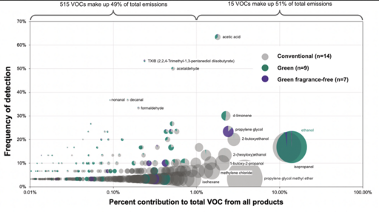Even “Green” Cleaning Products in US Emit VOCs Linked to Cancer
Updated
The deception related to products touted as safe in America continues. Like the bombshell revelation that the “safe and effective” mRNA COVID-19 jabs are neither safe nor effective—a new study exposes that even “green” cleaning products in the United States pose real and dangerous health risks. That’s right, even products that boldly claim they meet the Environmental Protection Agency’s (EPA) Safe Products Standards may release hundreds of toxic chemicals.
The peer-reviewed study, titled “Volatile organic compounds emitted by conventional and “green” cleaning products in the U.S. market,” was published in the journal Chemosphere on Sept. 13 and was conducted by researchers from the non-profit Environmental Working Group (EWG). The cleaning products used for the study included laundry stain removers, carpet, floor, glass, wood, and all-purpose cleaners. As part of their study, EWG analyzed 28 cleaning products and two air fresheners for hazardous human-made chemicals known as volatile organic compounds (VOCs), checking the air quality impacts of the products and measuring the number, concentrations, and emission factors of VOCs.
According to the EPA, VOCs—which are a surprising source of much of the pollution in the U.S. and are common groundwater contaminants—are emitted by a wide array of thousands of products, including paints and lacquers, paint strippers, cleaning supplies, pesticides, building materials and furnishings, office equipment such as copiers and printers, correction fluids and carbonless copy paper, graphics and craft materials including glues and adhesives, permanent markers, and photographic solutions. The EPA website states, “VOCs include a variety of chemicals, some of which may have short and long-term adverse health effects.”
To conduct their study, EWG researchers purchased 30 cleaning products from online retailers between December 2019 and May 2022. Overall, they detected a total of 530 unique VOCs in those products, which they divided into three categories: “conventional” products, “green” products with fragrance, and “green” fragrance-free products. At least 193 VOCs were considered hazardous to health based on either the European Chemical Agency’s Classification and Labeling Inventory or the California Department of Toxic Substances Control Candidate Chemicals List.
The study found that “green” products did indeed emit VOCs but at a lower level than their “conventional” counterparts. Without naming brands, researchers described “green” products as being “advertised as healthier, non-toxic, or free from harmful chemicals, as well as products with a third-party certification for safety or environmental features.” The cleaners labeled “conventional” fell outside of that category. The study found that, on average, fragrance-free “green” products produced nearly eight times fewer VOC emissions than conventional products and four times fewer VOCs than green products that listed a fragrance on their label. That pattern remained for the number of hazardous VOCs in the cleaning products. On average, the “green” products emitted four chemicals classified as hazardous, compared to nearly 15 in green products with fragrance and 22 for conventional products. For comparison, studies suggest there are more than 400 VOCs in cigarette smoke.
Even though the eye-opening study is helpful, it is clear, like the shots, that corporate profit (indeed tied to government agencies) has trumped concern for the health of Americans. Remarkably, the toxic household cleaning market in the U.S. is valued at $7.73 billion in 2023, despite researchers knowing for years that those in the cleaning industry are more likely to suffer from respiratory problems than others. Studies have proven that respiratory problems and asthma have an established link to regular exposure to cleaning products.
In a press release on Wednesday, EWG spoke of the “unsettling details” of the study, noting that the 193 hazardous VOCs emitted by the cleaning products are identified as “having the potential to cause health harms such as respiratory system damage, increased cancer risk and developmental and reproductive impacts.” Oh, ok. Many of the same devastating risks as the gene-damaging COVID jabs. And, like the shots, the effects of VOCs are long-lasting, normalized, and overlooked. Shockingly, EWG stated that some products emit VOCs for days, weeks, or even months. Following the study’s release, Senior EWG scientist Dr. David Andrews told DailyMail.com:
“There is no established safe exposure value or limit for VOCs, nor are there specific health-based regulations for VOC emissions from cleaning products.
Some VOCs are much more hazardous than others, but which VOCs or VOC mixtures are causing the most harm hasn’t been established.
Our results found that about half of the total VOC emissions was from chemicals that have no established safe exposure level even in an industrial setting.
In the absence of clear research that identifies what chemicals are causing health harm, it is prudent to reduce total VOC exposure.”







